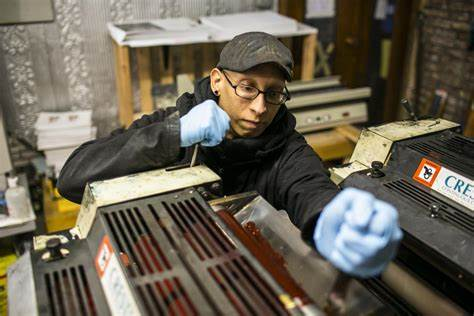
The year was 1941, and the globe was enveloped in the war against fascism, when a small collection of Vermont citizens watched their community be completely deprived of food and resources. To remedy the impending disaster, they pooled together the resources gained from “selling member shares” to conceive a new sort of store founded upon, “cooperative principles” and solidarity. Fast forward to 1944, and the motley group was purchasing their first storefront on Kimball Hill. Less than five decades later, in 1992, they collectively decided to relocate the store to Carol Brown Way in Putney, Vermont.
Their vision was a different kind of workplace, where instead of being centralized into a single boss or small collection of shareholders, ownership of the business and control over its trajectory and the wealth it generates was placed into the hands of everyone who steadfastly dedicates their labor to said business.
Theirs would be a workplace where the role of worker and owner were synonymous with each other, and the division between the two classes which generates such strife is rendered nonexistent. And their Putney Food Co-op has dutifully served the needs and desires of its customers, worker-owners, and the community at-large since its founding.
Discussions attempting to analyze the merits and demerits of the capitalist production and distribution model, and its oft-slandered alternatives, unsurprisingly become contentious whenever they are held within free market dominance’s most illustrative instance around the world and particularly in the western world. In 2023 alone, such debates regarding economic rights and ownership are embroiling a plethora of industries in turmoil, encouraging workers ranging from baristas to autoworkers to Hollywood writers to form unions, enter picket lines, and demand better pay, conditions and respect from their bosses. It is within these circumstances that cooperatives across America intend to bridge ideological chasms and introduce the multitude to the boons of a functioning solidarity-based economy.
Yet just how effective are they at leading our national conversation through example? “I don’t expect interactions with collectively owned organizations to injure people’s perspectives on such scare words,” stated Landmark economics professor Jeanette Landin. Landin later noticed during her shopping trips that each of the co-ops operating within Vermont aids prospective salespeople, reporting that the “Putney coop… works with needlers who sell items,” while, “the Brattleboro coop permits local artisans to sell their items.” Permitting working people unrelated to one’s business to sell their wares with assistance certainly would instill inside them an understanding of how valuable solidaristic and cooperative principles could be to their local economies.
When inquired regarding her own experiences shopping within the Putney and Brattleboro cooperatives, Landin reported, “Everyone there is friendly and helpful. It has always been a great experience being at the coops when I am the shopper.” The individuals laboring within the cooperative model appear to be equally dedicated, at least to guaranteeing their customer base is satisfied with their service quality alongside the provided products.
Landin’s perspective would be shared by Brian Van Skye, a columnist for the muckraking magazine Truthout and a worker-owner of the board game producer, TESA Collective. Van Skye cited multiple studies from France, Spain, Uruguay, and the United States endeavoring to juxtapose different business models with each other, focusing specifically upon comparisons between the cooperatives and business organizations dependent upon the boss-worker hierarchy. Each study occurred in a different period in the 21st century and focused upon whether rudimentary functioning within business could be maintained by its organizers, referencing “The hazard of dissolution,” meaning whether their business remains intact, and the ability to survive “through their first six to ten years.” And each study realized the “resiliency,” maintained by the worker-cooperatives juxtaposed to traditional business models especially during periods when the economy is in crisis, regularly surpassed those present within hierarchal and traditionally organized firms. One such study placed dissolution rates twenty percent lower than their orthodox capitalistic peers. Inside reasonable circumstances, it is entirely possible for non-hierarchical economic models to outperform traditional ones, paving the way to a gentler, more democratic economy and civilization.
Although investigations into the worker-cooperative model were initiated via a wide variety of involved parties within academic institutions and from within the organizations themselves, each and all attained a positive impression concerning said model’s present and future.
Contributing to such diverse yet nearly unanimous perspectives from an academic perspective would be Professor Loren Wehmeyer, an educator at an Entrepreneurship and Innovation class for Landmark College. Asked whether any lessons for current progressive activism could be gleaned from worker cooperative participation in labor movements directly south of us, in places like Mexico and South America, he stated, “I imagine that they do.” His impression was already vindicated in the years of turmoil enveloping said areas, owing largely to the NAFTA trade agreement and similar political calculations intended to render South American nations more “business friendly” and closer toward America’s economic agenda.
Within Brazil, the Landless Worker’s Movement’s daring and tireless activism for the rights, diverse cultures, and land of Brazil’s farmers and working class earned it formal recognition from the Right Livelihood award organization. It boasts a leaderless structure, prioritizing horizontalism, consensus gathering, and reflection among its rank and file. The Landless Workers Movement cites among its inspirations the Zapatista Army of National Liberation, which formed in the wake of NAFTA to defend the interests of indigenous Mexicans. They managed to successfully repel the Mexican army and seize control of large portions of Chiapas, which they manage collectively through horizontally organized Councils of Good Government and an economy almost entirely composed of workers cooperatives. The Zapatista’s cooperative economy successfully managed to improve health outcomes among its civilian populations relative to Mexico’s official government, sell tens of millions worth of goods to the open market, and systemically reduce outbreaks of violence within their communities. In the wake of such enormous and nation changing accomplishments abroad, Professor Wehmeyer was asked if interactions between average individuals and similarly collectively owned organizations would soften their impulse to eschew ideological “scare terms,” including Anarchism, Communism, and Socialism, to which he offered his “suspicion,” that it “could be the case”. Provided one considers the scope of the changes very near to our nation engendered over a small period of time marked indisputably with millions of such interactions, to hold that hope should not be labeled unreasonable.
Even following the Cold War, the concept of a hierarchal boss-worker and manager-worker relationship was considered to be sacrosanct in the western world’s culture. Alongside successful challenges to such a model, a more critical perspective of our nation’s customs and shibboleths is likewise amassing prominence. Whether these emergent perspectives will succeed in the test of history will be dependent upon the tenacity of its founders.
Works Cited
Pandemic Crash Shows Worker Co-ops Are More Resilient Than Traditional Business | Truthout
Our Story — The Putney Food Coop
End to WGA strike is in sight: Writers Guild and studios reach tentative agreement (msn.com)
Prosser Starbucks becomes third store to unionize in Eastern Washington | News | nbcrightnow.com
Taking On Starbucks, Inspired by Bernie Sanders – The New York Times (nytimes.com)
Bolingbrook, Naperville join other UAW auto workers on strike (msn.com)
Movimento dos Trabalhadores Rurais sem Terra (MST) – Right Livelihood
Gautney, Heather; Omar Dahbour; Ashley Dawson; Neil Smith (2009). Democracy, States, and the Struggle for Global Justice. New York, New York: Routledge Cavendish. pp. 244–245. ISBN 978-0-415-98983-1.
Gustavo Esteva “Liberty According to the Zapatistas”
Castellanos, Laura (2014-01-04). “El suicidio ronda en San Andrés”. El Universal (in Mexican Spanish). Retrieved 2020-06-16.





